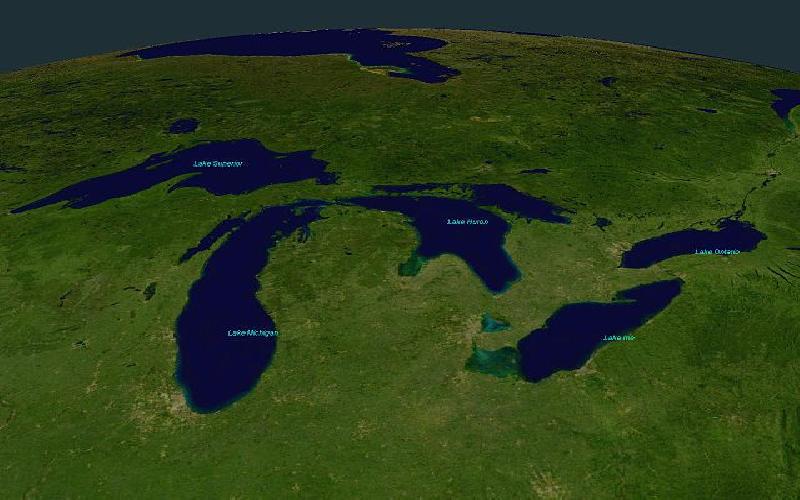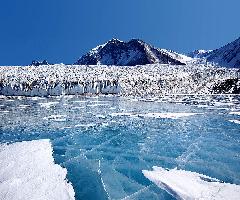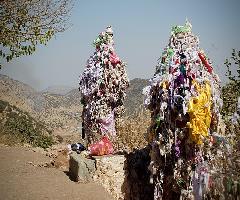The 20th July initiative : The Lake Superior day
The 20th of July will be celebrated by a large number of Northlanders as the ‘Lake Superior Day’, an event full of concerts, community events and awareness campaigns to create awareness about the Great lakes, and the dangers imposed on its ecosystem by various direct and indirect human interventions. People from across United States and Canada joined the event in their own way, while the world - networked through the web and the media - watched and learnt a lesson or two in natural history and environmental economics.
The Great Lakes : an Overview
The 'Great Lakes' refer to five large freshwater lakes situated in the bordering territory of United States and Canada. Together, Lakes SUPERIOR, MICHIGAN, HURON, ERIE and ONTARIO contain almost 22% of the total freshwater available on the planet, making it by far the largest freshwater system. Recently, Lake CHAPLAIN, on the border of New York and North West Vermont was labelled as the sixth Great Lake on March 6, 1998 when President Clinton signed the Senate Bill 927.
These lakes, connected through many connecting channels surround over 35,000 islands dispersed in them. Some of them, like Manitoulin Island in Lake Huron, are large enough to have their own lakes within the island. Together, they are spread over around 94,250 square miles and hold about 23,000 cubic km of water, enough to cover all the forty eight stated of United States with a 9 feet thick layer of water.
They have an important moderating impact on the local climate, called 'Lake effect', resulting from absorption of heat in summer and its release in winter. By virtue of its enormous dimensions they form one of the extremely important freshwater eco-systems of the world that is constantly under threat from various human activities in different forms.
Natural History of Great Lakes
The Great Lakes are themselves a very recent phenomenon that came into existence only about 10,000 years ago. However, their foundations were laid down much earlier, between two to three billion years back, during the Precambrian era. It was largely a result of volcanic activity and tectonic shifts that created the borders and the basin of the Lake Superior. About one and a half billion years later, or around 570 million years ago, another fault line developed in the form of Saint Lawrence rift that formed the basin for Lakes Ontario and Erie, along with Lawrence River.
The Northern and North Western portion of Great lake basin is formed by Canadian Shield, which also forms the basement of the Southern and Eastern portions of the basin formed by the Paleozoic sedimentary rocks.
In the Paleozoic Era, the territory identified today as central North America was flooded by marine seas full of life forms, like corals, crinoids, brachiopods and molluscs. The seas deposited lime silts, clays, sand and salts that consolidated with time into limestone, shale, sandstone, halite and gypsum.
In the Pleistocene Epoch, over a million years ago, the continental glaciers, up to 2,000 metres (6,500 feet) thick, advanced over the Great Lakes region from the north. These massive ice bodies levelled the ground and deepened the foundation of great lakes further. Thousands of years later, as the climate began to warm further, the glaciers melted and filled the region. When the ice age returned, waters were frozen and new glaciers came from the North. During the interglacial period, vegetation and wildlife developed.
Development of Human Settlement & Economic Activity
The Great Lake basins have been vital to the human settlement and economic growth in the region and are home today to about one-tenth of population of United States and around one-fourth population of Canada.
The original settlers arrived here about 10,000 years ago, and since then this has been host to the largest human concentration in the continent. The population in sixteenth century was around 60,000 to 100,000 before the Europeans made it their base in seventeenth century. It was a site of a showdown between the British and the French that ended with the British capture of Quebec in 1759. After the American Revolution the Great Lakes basin became the boundary between the new U.S. republic and residual British North America, that later became Canada.
The War of 1812 was to some extent a struggle for the wealth of Great lakes area. After it commercial and economic activity in the region accelerated a great deal. Agriculture was the most important activity in early years, with about 400,000 people in Michigan, 300,000 in Wisconsin and perhaps half a million in Upper Canada settling for the purpose of making it their livelihood. With time, logging, timber, shipping and transport, and commercial fisheries gained importance as economic enterprise. In the last century, rapid urbanization changed the face of most settlements. Sports and recreation were added as major enterprise and services became the
Cause for Concern : Dangers to the Great Lakes Eco-system
The existing eco-system appears to have been in uninterrupted existence since the last 10,000 years, with more or less stable water levels until recently. However, there are several significant concerns that have arisen recently, and which need urgent care and attention.
-
FALL IN WATER LEVELS : REPLACEMENT OF WATER REMOVED - Most of the water in Great lakes is non-renewable and cannot be replaced by precipitation, which equals to only about 1% of total water. This has a crucial implication. Although the Great Lake system has enormous quantities of water stored, this water cannot be replaced or renewed by any means. This creates a constraint on unabated removal of water. In 1998, the Canadian company Nova Group's plans to withdraw 158,000,000 US gallons (600,000 cubic meters) of Lake Superior water annually to ship by tanker to Asian countries had to be shelved due to public outcry even before the project could take off. Public outcry forced the company to abandon the plan before it began. Subsequently, the eight Great Lakes Governors and the Premiers of Ontario and Quebec have negotiated the Great Lakes-St. Lawrence River Basin Sustainable Water Resources Agreement and the Great Lakes-St. Lawrence River Basin Water Resources Compact that prevent future big scale diversion proposals.
-
IMPACT OF GLOBAL WARMING - Higher temperature in the coming years due to global warming are predicted to cause more water loss due to evaporation that may bring down the water levels in the lakes. However, these apprehensions may not come true if the water precipitation in the region is also increased due to global warming.
-
IMPACT OF GROUNDWATER OVER EXPLOITATION - Groundwater is one of the most important sources of water renewal in the Great lakes. In the last few decades, the groundwater has been increasingly exploited by urban settlements around the lakes, that has lead to falling groundwater levels and raised concerns of fall in the role of ground water as a renewing source.
-
DANGERS FROM ALIEN, INVASIVE SPECIES - A number of non-native, alien species have intruded into the Great lake system through the transportation routes created. These have disturbed the pre-existing flora and fauna and pose a danger of destabilising the ecological balance. The major irritant species include SEA LAMPREY, a parasite that attaches to large fishes and consume flesh and fluid from its prey. It is said to have caused a loss of around US $ 138 billion per annum. Another alien species is ZEBRA MUSSEL, a Mollusc that poses dangers by reducing the food available for fish. Its presence can put a strain in the ecological cycle. ALEWIFE, a species of herring, introduced through the canal systems littered beaches each spring and altered food webs, requiring intentional introduction of salmonids, stocked as predators to keep alewife populations under control. ROUND GOBY, WATER FLEAS and ASIAN CARPS are some other alien species that threaten to disturb the stable eco-system.
-
REDUCTION IN FISHERY PRODUCTION - Fisheries are one of the most economic activities undertaken in the lake areas. In the last couple of centuries, the fisheries output has been reduced. Wisconsin Fisheries Commission noted a reduction of roughly 25 percent in general fish harvests by 1875. One of the reasons for this fall was Logging of timber that lead to encroachment upon spawning spaces once the timber was removed.
The Governments are also stepping in
The U.S. Environmental Protection Agency has identified 47 areas of concern in the Great Lake - St. Lawrence River basin. 26 of these areas are located entirely within the United States, while 12 are located within Canada. The remaining 5 fall partially within both. Rapid Action Plans are being developed for every one of these areas. The action contemplated includes placing restrictions on fish and wildlife consumption, dredging activities, or drinking water consumption.
All in all, it is not that there is no awareness about the challenges in preserving these magnificent water bodies. The people and more recently, the Government agencies have also become conscious of the issue. However, market driven over-exploitation continues somewhat unabated, as also the resultant pollution and interference with their eco-systems. Hence, there is a need for more – greater awareness, greater public participation, greater self-restraint as well as greater regulation of market exploitation.
We need more care and attention!










